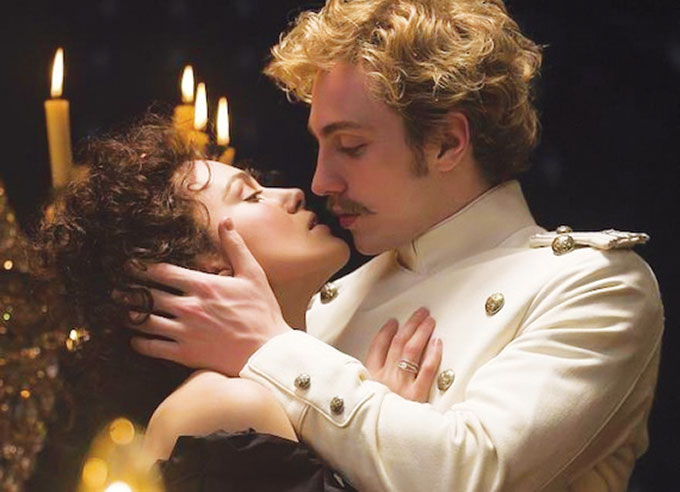Anna Karenina
by George Sax

A fool for love, again
Anna Karenina
In the most recent of their really very serious periodic Sunday-edition dialogues, New York Times film critics A. O. Scott and Manohla Dargis addressed current motion pictures that employ nontraditional narrative methods, movies that, in Dargis’s words, “dispense with either all or part of the mainstream storytelling playbook.” In the course of their ostensible, editorially concocted, and sometimes ponderous “conversation” (which includes perfectly quoted excerpts from other writers’ work), they agree that this is an important, even “thrilling” trend.
Neither of them has reference to Joe Wright’s new adaptation of Leo Tolstoy’s renowned novel Anna Karenina, but they might have. There is, of course, a famous central story arc in the novel and previous adaptations—there are at least five English-language sound and silent-era versions—have followed it, but Wright’s treatment is not what would reasonably be called reverentially faithful. Like those previous movies, he and his screenwriter, playwright Tom Stoppard, have retained much of the important story elements and all the central characters. But Wright’s approach—and it is his, not Stoppard’s—can hardly be called a reliably faithful transfer to the screen.
In Tolstoy’s sprawling, complexly constructed novel, he sought to convey a portrait of mid-19th-century Russian society in all its stark and oppressive class structure, especially its decadently hypocritical ruling class. As in the book, Anna (Keira Knightley) is the still-young wife of Kerenin (Jude Law), a dutiful, upright aristocrat and highly placed official in the Tzar’s government in Saint Petersburg. Anna attracts the attentions of Count Vronsky (Aaron Taylor-Johnson), a promiscuously adventuristic young army officer who lays passionate siege to her less than sturdy moral defenses. Their doomed affair leads, as it must, to the dissolution of her marriage and, literally, to her destruction. To her social peers and husband, Anna’s real crime is to be so obvious and exposed in her erotic obsession. Her offense is also to be a female in a world where a woman whose husband divorces her loses her children and is forbidden to remarry.
Wright and Stoppard more or less get most of this down, but the pictures plays it out in a stridently artificial setting. The conceit of Wright’s movie is to place Anna, Vronsky and Karenin’s story in a little jewel box of a theatre. This Anna begins with a long shot of a curtain noisily rising within a proscenium arch as the action begins, action that expands throughout what, it almost immediately becomes clear, is an impossible expansive and imaginary theater, one which can accommodate drawing rooms, bed chambers, balls, street scenes, even a horse track. The results are startling, amusing, and sometimes dazzling.
Wright executed his framing concept with a fluid, brilliant vividness. And the point of all his intricately constructed, magically shifting artifice is hardly obscure. This elaborate hide-in-plain-sight trickery is meant to underscore the artificial, cynically corrupt and potentially punitive nature of the Russian social and political order. Wright has amplified this tricked-up environment with occasional artificial stylization of the actors’ movements. In the ballroom where Anna crucially encounters Vronsky, the dancing is at once formal and expressive. And this device is carried over to one or two other scenes, in particular one in a government office where a desk-bound squadron of minor functionaries stamps documents in choreographed unison.
This is all less a neo-Brechtian alienation than a filmmaker’s vivid elaboration of an interpretive idea, one he doubtless considers friendly to Tolstoy’s work. But it soon enough becomes clear that it’s not. It’s distracting and restricting. Earnestly worthy adaptations of literary classics are often dismissed with faint praise by critics, as Scott did in response to Wright’s 2005 movie of Jane Austen’s Pride and Prejudice, but this adaptation winds up trivializing the novel and its characters. For all its dynamically arresting imagery and effects, Wright’s Anna becomes constrictive. Early on, when Taylor-Johnson’s Vronsky exclaims to Anna during the ball, “If I’m not to dance with you, then I’m getting out of this operetta,” the line has an unintended resonance. This is like Tolstoy under glass.
And there is a curious irony in the evocative, dramatically involving country scenes, rendered with a vibrant naturalism, involving the idealistically liberal young landowner Constantine Levin (Domhnall Gleeson), a probable stand-in for Tolstoy. The contrast may be meant to emphasize the conflicts in social practices and visions, but it also inadvertently calls attention to the precious quality of the other scenes’ self-conscious manipulation.
Part of the film’s failure to achieve a dramatic force is due to the title performance. The miscast Knightley comes across as impulsively and neurotically immature. Film critic and novelist James Agee, reviewing an earlier movie version, called Anna “one of fiction’s most vehemently average women,” but if that’s the intended point here, it’s not communicated. Taylor-Johnson’s Vronsky, with a two-toned, marcelled hairdo and a silly mustache, presents no reasonable approximation of a young man who could command a woman’s tragic ardor.
Jude Law, of all actors, comes off best. His Karenin is nuanced, conflicted and even sympathetic. What can you say of a movie about passionate destruction in which Law’s performance as a devoutly moral, wounded husband is the most persuasive?
Watch the trailer for Anna Karenina
|
Issue Navigation> Issue Index > v11n48 (Week of Thursday, November 29) > Film Reviews > Anna Karenina This Week's Issue • Artvoice Daily • Artvoice TV • Events Calendar • Classifieds |









 Current Issue
Current Issue